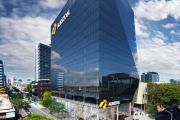
Tamarama surf club hopes major refurb will boost female membership
Lately, anyone permitted to exercise along Sydney’s popular Coastal Walk from Coogee to Bondi would have brushed past the Tamarama Surf Life Saving Club and sussed that something’s afoot behind the recently erected hoardings.
The stepped and stripped-down art deco facade of the building – which houses one of the country’s foundation surf lifesaving clubs – became nationally familiar when, in 2013, in a livery of yellow and blue, it starred in a paint commercial.
In the ad and from a distance it all looked to be in sparkling shape.
But members knew that inside all was not exactly maintained or functioning as it should have been. And because the original club shack was rebuilt in the 1940s, in an era when there were no female lifesavers, there weren’t decent facilities for the girls.
“There was hazardous material, health and safety issues, and the place was a patchwork,” says Tamarama Building Committee chairman Mike Turner. “It was basically falling down.”
The essential refurbishment project that is finally underway after a slow decade of consultation, planning and fundraising will redress those and a host of other issues so that by the middle of next year – hopefully when beach life assumes a semi-familiar post -COVID shape – Tamarama SLSC will re-present itself as a much-improved Sydney icon.
The relatively modest budget that architecture firm Chrofi is working with will not make for highly evident external changes. While not specifically heritage listed, that famous facade is being retained and most of what is being amended is happening behind it and on the sea-front side.
To better fulfil its life-preserving role at a small beach noted for exceptionally dangerous rips, improved equipment storage and first-aid facilities have been prioritised. So has the surveillance outlook, or what Turner calls “better optics of the beach”.
Established in 1906, the club is keen to attract more female membership, conducts training programs for indigenous youth and migrant groups and has, Turner says, “a huge public interface” that sees it used for classes such as yoga. With this in mind, the renewal programme includes an upstairs function space with an epic ocean outlook through a large, curved corner window.
Chrofi director Steven Fighera says the planning required “a full rethink in terms of the functionality of what was a sub-standard club”.
“We had to reimagine how it could operate on a small, 500 square metre site,” he says.
One of the main strategies, he adds, has been “to separate wet functions – the large storage hall and wet areas where people come in dripping wet – from dry”.
Chrofi is inserting a boardwalk-style corridor through the downstairs members’ area. To introduce better natural illumination, a long skylight softened by timber battens is being installed.
The generous application of Blackbutt timber is, Fighera says, an aspect of “trying to keep the material palette pared back”.
With no airconditioning and scope for opening up so much of the building, the refresh is about “envisioning an open and porous building – beachy is the key”.
On a structure with no place to hide from battering weather, externally the walls are being reinstated in compressed fibro-cement sheets in contrasting tones of sandstone and dark grey. With the colour inherent in the material, no future painting will be required.
Those changed tonal options – “Our call,” says Fighera – mean Tamarama SLSC will no longer stand out as the place daubed yellow and blue but will look more environmentally empathetic to the rocky promontory on which it sits.
Why this project that was discussed in the club for a decade has taken so long to commence has had much to do with raising the money required.
“That proved a challenge,” Turner says. Even with partnership buy-in and project management from Waverley Council, “We got three-quarters of the way there and then hit a dead end. What saved us was COVID and the fact that the state government was looking for shovel-ready projects.
“So council and the state government finally got us over the line.”
It is, Fighera says, “great to see it finally happening”.
“We’re making such transformational change but doing it without changing the building in a major way. It’s all happening behind the facade.”










